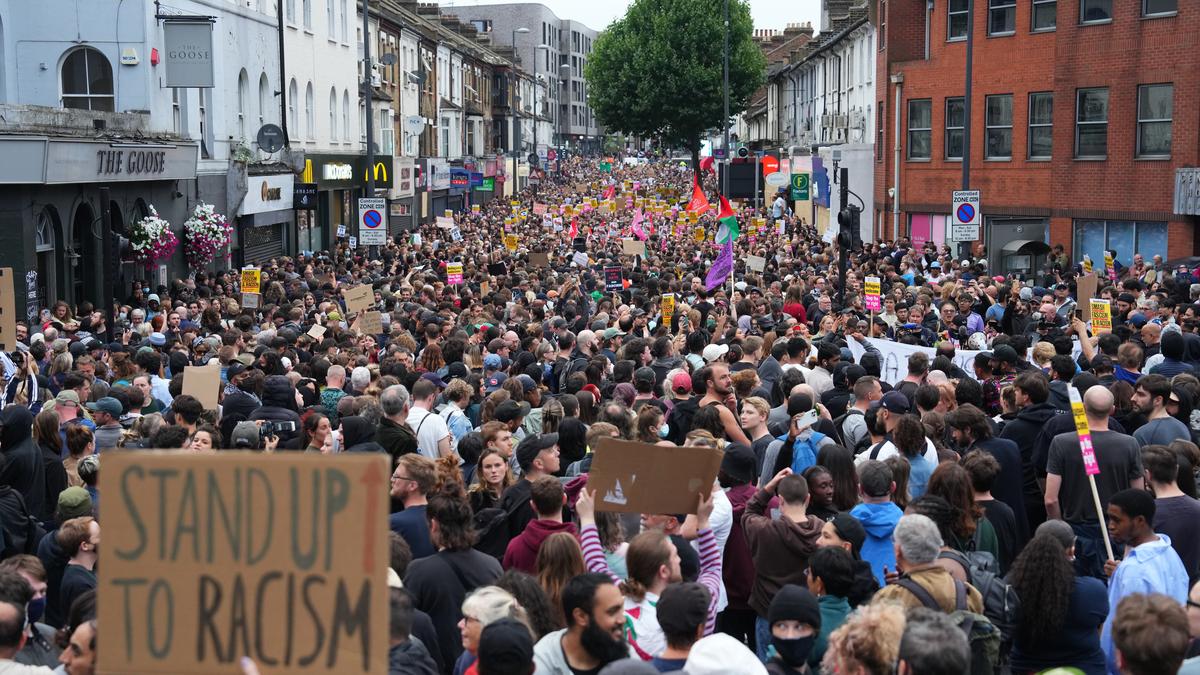Counter protesters assemble ahead of a potential anti-immigration protest in Walthamstow, United Kingdom on on August 7.
| Photo Credit: Getty Images
The story so far: The recent far right riots in Britain are a continuation of the phenomenon of urban rioting that the country regularly experiences, especially in the summer months such as the 1981 violence in Brixton in London and Toxteth in Liverpool; or in northern deindustrialised towns such as Burnley and Oldham in 2001. While previous rounds of violence witnessed youngsters from black and ethnic minority backgrounds in pitched battles with the police who were accused of being racially motivated and discriminatory, this year’s summer violence involved men from white working-class backgrounds attacking, in some cases a mosque and hotels where immigrants were staying.
What led to the riots?
In this round of race riots, social media played an almost incendiary role, exponentially spreading misinformation. The immediate spark to the violence was the rumour that the perpetrator of the knife attack in the town of Southport, which killed three young girls, was Muslim and an immigrant who had recently arrived on a boat. Controversial far-right figures like the English Defence League co-founder, Tommy Robinson, took to social media on the issue, resulting in many of his followers violently taking to the streets.

The riots are a culmination of decades of dehumanising immigrants. Former U.K. Prime Minister, Theresa May, when she was Home Secretary in the David Cameron government, created what was called a ‘hostile environment’ in order to bully illegal immigrants into leaving. This reached even more extreme levels under Home Secretaries Priti Patel and Suella Braverman. Indian origin Prime Minister Rishi Sunak contributed his share with his pull-up-the-drawbridges mentality and stop-the-boats-from-arriving sloganeering.
Signals from the highest levels of the British political establishment reinforce the unfounded belief that immigrants are harmful for British economy and society. The highlighting and headlining of immigration also serves to obfuscate the manner in which unemployment has arisen through a deliberate deindustrialisation, rather than immigrants snatching jobs; how there has been a shortfall in building social housing; and a general stretching, to breaking point, of public services such as the National Health Service (NHS) through systematic under-investment.
How has right-wing media reacted?
A curious phenomenon of these riots has been the concern towards the English working class by the right-wing media and commentariat. This plight was itself created through the declaration of a veritable class war when Margaret Thatcher during the miners’ strike, called the National Union of Miners (NUM) as the ‘enemy within’, drawing a parallel to the ‘enemy without’ in the form of the Argentine junta that had been defeated in the 1982 Falklands War. Historically, working class unrest in Britain such as the 1819 Peterloo massacre, or the 1984 miners’ strike has had the potential to challenge and change the British establishment on more equitable and socially just grounds. The right wing commentariat does not visualise their working class framing of the current riots in this transformative manner. They have not been worried about the aggravation of working-class conditions owing to 14 years of austerity measures imposed by Conservative governments since 2010.
The current riots must also be understood as a far-right reaction to pro-Palestine protests across British cities that have called for a ceasefire in the face of Israeli military actions in Gaza. These protests were labelled as hate marches and anti-Semitic by the right-wing media. The possibility of further far-right violence was thwarted by anti-race protesters on the streets that the Labour government tended to be frigid towards. The Keir Starmer led government is unlikely to challenge the far-right, fearing a shift of support towards the immigration obsessed Reform U.K. Party, that received four million votes in the July elections. The Starmer government’s ability to handle the violence is undermined by the prolonged austerity measures that have generally compromised the capabilities of the British state.
Amir Ali teaches at the Centre for Political Studies, JNU, New Delhi

Vikram Sharma is a globe-trotting journalist with a global perspective on international events. His articles offer readers a global perspective on international events, exploring complex geopolitical issues and providing insights into the world’s most pressing challenges.


